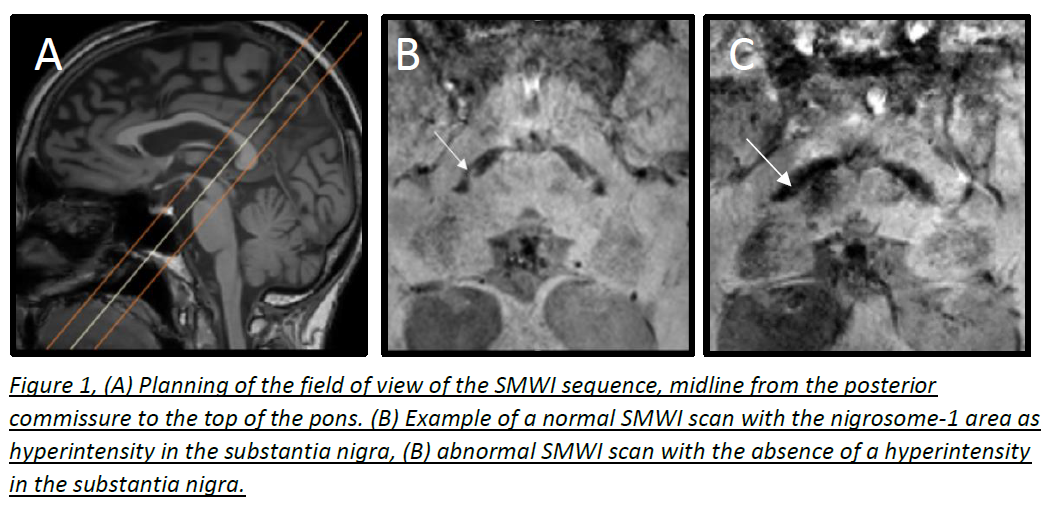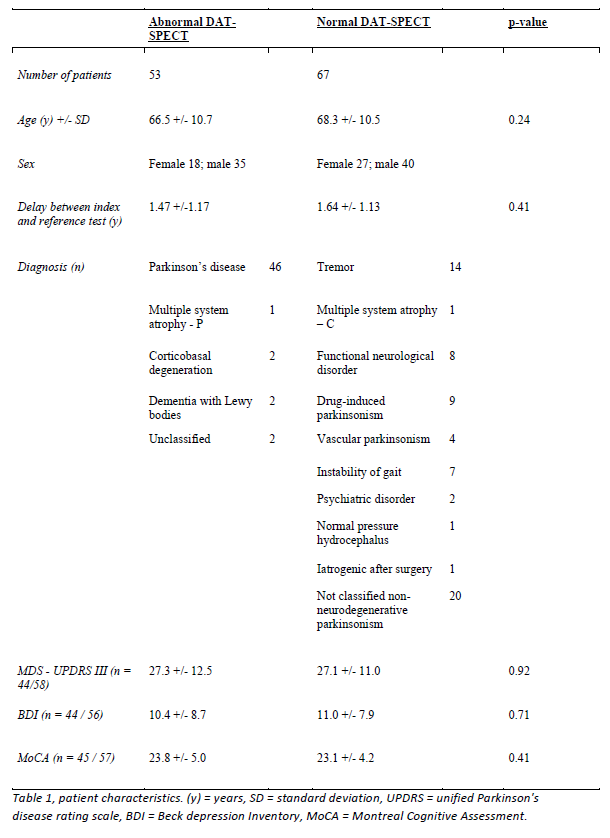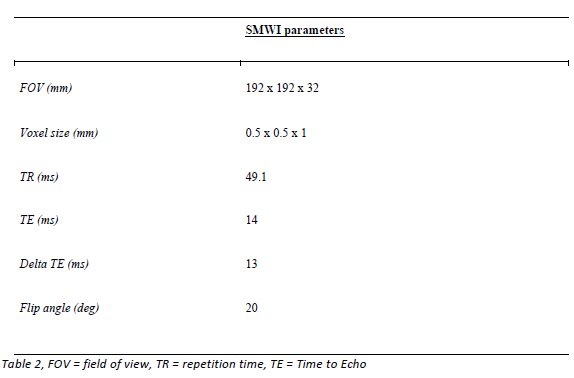Category: Parkinson's Disease: Neuroimaging
Objective: To determine the accuracy of AI-driven automated diagnostic software analyzing susceptibility map-weighted imaging (SMWI) to distinguish neurodegenerative from non-neurodegenerative parkinsonism in patients who had a dopamine transporter SPECT scan (DAT SPECT), using [123I]FP-CIT as tracer, because of a clinically uncertain Parkinsonian syndrome (CUPS).
Background: Degeneration of the dopaminergic cells in the substantia nigra (SN) in Parkinson’s disease (PD) is accompanied by locally increased iron deposition, particularly in the cell dense nigrosome-1 region. SMWI is a novel MRI technique combining magnitude images with quantitative susceptibility mapping to enhance the susceptibility to iron. Therefore, SMWI is capable to visualize the nigrosome-1 and reduced visibility in patients with PD caused by the increased deposition of iron.1 In this study, we aimed to assess the diagnostic accuracy of diagnostic SMWI software in patients who presented with CUPS.
Method: Between January 2019 and July 2023, a diagnostic accuracy study was conducted, including patients who visited a neurologist with parkinsonism and had a DAT SPECT scan because of CUPS. The index diagnostic test was the result of AI-driven diagnostic software analyzing the nigrosome-1 on SMWI as normal or abnormal. The results were compared with the final diagnosis (including DAT SPECT) as reference.
Results: Currently, 132 patients are included in the study. The DAT SPECT scan results were abnormal in 53 patients, and normal in 67 patients, there was no difference in symptom assessment scales between groups. Twelve patients were excluded from the analysis, four patients because the diagnosis remained uncertain and eight patients because of artifacts on MRI. The diagnostic accuracy of the AI-driven SMWI software was 88% to differentiate patients with neurodegenerative parkinsonism from patients with non-neurodegenerative parkinsonism in the preliminary analysis (sensitivity 87%, specificity 89%).
Conclusion: The diagnostic accuracy of SMWI based diagnostic software was promising in this study that assessed the diagnostic value in a novel relevant population of patients who presented with CUPS. A limitation of this study is the average delay between index and reference test of 1.6 years. This study warrants prospective trials to further investigate the diagnostic value.2
figure 1.
table 1.
table 2.
References: 1. Gho SM, Liu C, Li W, Jang U, Kim EY, Hwang D, Kim DH. Susceptibility map-weighted imaging (SMWI) for neuroimaging. Magn Reson Med 2014; 72(2): 337-46.
2. Elon D. Wallert, Elsmarieke van de Giessen, Martijn Beudel, Dong Hoon Shin, Tom van Mierlo, Jeroen Blankevoort, Henk W. Berendse, Rob M.A. de Bie, Jan Booij. (2024, Februari 28 – March 3), European Congress of Radiology [oral presentation], Austria Center, Vienna, Austria.
To cite this abstract in AMA style:
E. Wallert, E. V.D. Giessen, M. Beudel, T. van Mierlo, J. Blankevoort, DH. Shin, R. de Bie, J. Booij. Accuracy of AI-driven automated diagnostic software analyzing Susceptibility Map-Weighted Imaging to Differentiate Neurodegenerative from Non-neurodegenerative Parkinsonism [abstract]. Mov Disord. 2024; 39 (suppl 1). https://www.mdsabstracts.org/abstract/accuracy-of-ai-driven-automated-diagnostic-software-analyzing-susceptibility-map-weighted-imaging-to-differentiate-neurodegenerative-from-non-neurodegenerative-parkinsonism/. Accessed January 7, 2026.« Back to 2024 International Congress
MDS Abstracts - https://www.mdsabstracts.org/abstract/accuracy-of-ai-driven-automated-diagnostic-software-analyzing-susceptibility-map-weighted-imaging-to-differentiate-neurodegenerative-from-non-neurodegenerative-parkinsonism/



